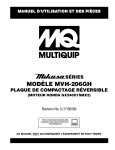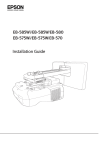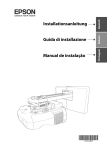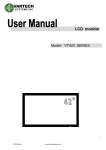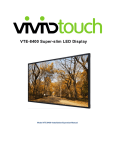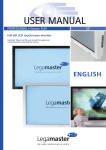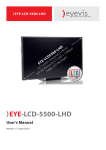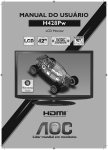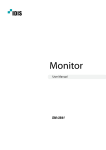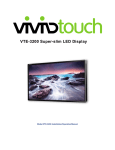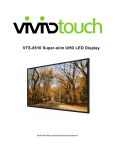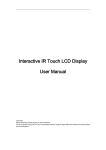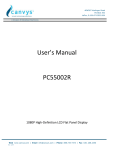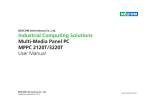Download User_Manual_INT65ABHa_V01
Transcript
LCD monitor Models: INX/T/F65ABHa 1 Contents Document History ................................................................................................................................ 4 Important Safety Instructions ............................................................................................................... 5 Safety Precautions............................................................................................................................ 5 Installation ....................................................................................................................................... 6 Use ................................................................................................................................................... 7 Cleaning ........................................................................................................................................... 8 Warnings .............................................................................................................................................. 8 Use ................................................................................................................................................... 8 Exemptions ...................................................................................................................................... 8 Using Touch Monitor near Light Sources ............................................................................................ 9 Notice ............................................................................................................................................... 9 Product Features................................................................................................................................. 10 Package Contents ............................................................................................................................... 10 Unpacking ...................................................................................................................................... 10 Packing list ..................................................................................................................................... 11 Included Accessories...................................................................................................................... 12 Product Overview .............................................................................................................................. 13 Main Power Switch and AC Inlet .................................................................................................. 13 Power Switches .............................................................................................................................. 13 Input and Output Connectors ......................................................................................................... 14 Operating the Monitor........................................................................................................................ 15 Setting up the Monitor ................................................................................................................... 15 Turning Monitor On and Off ......................................................................................................... 16 Adjusting Volume and Input Source .............................................................................................. 16 Using the Keypad........................................................................................................................... 17 Reading the Status LED ................................................................................................................. 17 Avoiding Image Retention ............................................................................................................. 18 Using the Remote Control ............................................................................................................. 19 Locking the OSD (On-screen Display) .......................................................................................... 19 Changing the Remote Control Battery........................................................................................... 20 Mounting an IPC (Integrated PC) .................................................................................................. 21 Using PIP (Picture-in-Picture) Mode ............................................................................................. 22 Using the Menus ................................................................................................................................ 24 Navigating through the Menu System ........................................................................................... 24 On-Screen Display (OSD) Overview............................................................................................. 24 Image Settings Menu ..................................................................................................................... 26 Display Settings Menu ................................................................................................................... 28 Audio Settings Menu ..................................................................................................................... 29 Basic Settings Menu ...................................................................................................................... 30 Advanced Settings Menu ............................................................................................................... 32 Advanced Settings Menu (Optional Ethernet Control).................................................................. 34 System Status Menu ....................................................................................................................... 35 User ADC (Analog-to-Digital Converter) Calibration .................................................................. 35 WOD Mode (Wake On Digital) ..................................................................................................... 36 Default Settings.............................................................................................................................. 37 Connecting the Touch Sensor (INT65ABHa Only) ........................................................................... 38 Supported Operating Systems ........................................................................................................ 38 Connecting the Touch Monitor to a Computer .............................................................................. 38 Controlling One or Several Monitors using RS-232.......................................................................... 39 Overview ........................................................................................................................................ 39 Connecting Multiple Monitors to a Single RS-232 Controller ...................................................... 39 Supported Timings ............................................................................................................................. 40 2 Specifications ..................................................................................................................................... 41 Troubleshooting ................................................................................................................................. 42 Dimensions (INX65ABHa and INT65ABHa) ................................................................................... 43 Dimensions (INF65ABHa) ................................................................................................................ 44 Compliance ........................................................................................................................................ 45 Appendix I: Moving and Carrying Notice ......................................................................................... 46 Appendix II: Installing Stands or Wall Mount ................................................................................... 47 Appendix III: Wall Mount Safety Notes ............................................................................................ 49 Appendix IV: Controlling the Monitor through Ethernet .................................................................. 51 Overview ........................................................................................................................................ 51 Locating the LAN Connector on your Monitor ............................................................................. 51 Assigning an IP Address to the Monitor ........................................................................................ 52 Connecting the Monitor to the Network ........................................................................................ 53 Installing the VCOM Driver .......................................................................................................... 53 3 Document History Title: INX/T/F65ABHa User Manual Issue Date: JAN. 2012 Revision: 01 Version Ver.0.1 Update 2012.JAN Remark First version release 4 Important Safety Instructions Before using this monitor, please read this user manual thoroughly to help protect against property damage and to ensure your personal safety and the safety of others. o Be sure to observe the following instructions. o For your safety, be sure to observe the warnings located in this manual. o For installation or adjustment, please follow the instructions in this manual and refer all servicing to qualified service personnel. Safety Precautions If smoke or a peculiar smell comes from the monitor, remove the power plug from the outlet immediately. Failure to do so may result in fire or electrical shock. Contact your dealer for inspection. If the monitor has been turned on but there isn’t a picture, remove the power plug from the outlet immediately. Failure to do so may result in fire or electrical shock. Contact your dealer for inspection. If water is spilled or objects are dropped inside the monitor, remove the power plug from the outlet immediately. Failure to do so may result in fire or electrical shock. Contact your dealer for inspection. If the monitor is dropped or the cabinet is damaged, remove the power plug from the outlet immediately. Failure to do so may result in fire or electrical shock. Contact your dealer for inspection. To turn off the power of the monitor, press “O” on the main power switch at side of monitor. The power standby/on indicator will go off and the monitor cannot to be turned on/off by using the POWER button on the remote control. (To turn on/off the monitor by the remote control, press the main power switch again and light the power standby/on indicator.) o When turning off the monitor by pressing the POWER button on the remote control, the main power of the monitor is not turned off completely. o To disconnect power completely, remove the power plug from the outlet. Press “O” to turn off the monitor completely 5 If the power cord or plug is damaged or becomes hot, turn off the main power switch of the monitor, make sure the power plug has cooled down and remove the power plug from the outlet. If the monitor is still used in this condition, it may cause fire or electrical shock. Contact your dealer for replacement. Installation Don't install in a high-temperature environment. If the monitor is used in high-temperature or in direct sunlight, it may cause the case or other parts to become distorted or damaged, resulting in overheating or electrical shock. Don't install in a high-humidity environment. This may cause overheating or electrical shock. Don't install near any heat sources such as radiators, heat registers, stoves, or other apparatus that produce heat. This may cause fire or electrical shock. Don't overload outlets or cables beyond electrical capacity. Don't use extension cords as it may cause fire or electrical shock. Don't insert the power plug into an outlet other than 100~240V AC. This may cause fire or electrical shock. o Don’t use a damaged power plug or worn outlet. o Don’t insert an improper power plug it may cause fire or electric shock. Don't place the monitor on an unstable shelf or surface. The monitor may fall, causing injury. Please install on a horizontal, stable, level surface. Don't place objects on the monitor. o If the monitor is covered or the vents are blocked, the monitor could overheat and cause a fire. o If metal or liquid gets into the monitor, it may cause fire or electrical shock. o Do not put heavy objects on the monitor as they may fall, causing injury. o Please keep a 10 cm minimum distance between the monitor and the wall for sufficient ventilation. Don't move the monitor when it is connected to the power cord and AV cables. o When moving the monitor, make sure to remove the power plug and cables from the outlet or source. o When unpacking or carrying the monitor, at least 2 people are needed. Make sure the monitor is carried upright. o Transport the monitor upright. Avoid placing the monitor face up or down. o Handle the monitor gently. Do not drop. 6 Use If you encounter a problem during installation, please contact your dealer for assistance. Don’t repair or open the monitor by yourself. Failure to do so may result in fire or electrical shock. Contact your dealer for inspection. Protect and correctly use the power cord/plug. o Don't pinch the power cord/plug between hard surfaces. o Don't step on the power cord/plug. o Before inserting the power plug into the wall outlet, connect the power cord to the monitor. o Don't operate the monitor with a damaged power cord or it may damage the monitor. Using extension cords (not recommended) If an extension cord must be used, ensure the voltage rating exceeds the max power consumption of the monitor. If the voltage rating is less than the monitor, it will cause the extension cord to overheat. If there is thunder or lightning, don’t touch the monitor or the power plug. This may cause an electric shock. Don’t use any kind of liquid on the monitor. o If liquid is spilled on the monitor, remove the power and ask qualified service personnel to check the monitor. o If the liquid gets on the monitor’s screen, please clean it with a dry and soft cloth immediately. o Don’t use any harsh chemical on the monitor. o If metal or liquid gets into the monitor, it may cause a fire or an electrical shock. Don’t install or remove the power plug with wet hands. This may cause an electrical shock. If the monitor will not be used for a long period of time, unplug the monitor. This may cause premature wear of electrical components or fire. Don’t press on the LCD panel. This may cause personal injury or panel damage. Don't push or shake the monitor. This may cause damage or injury. o If the glass of the monitor panel is broken, liquid may escape. Please don't touch the liquid. o If liquid get into your eyes or touches your skin, wash with the clean water and seek medical attention immediately. Precautions with the remote control batteries o Please only use approved AAA type batteries. o Please be sure to insert batteries by matching the + and -. o Don’t recharge, heat, disassemble, short or throw batteries into a fire. o Don’t mix a new battery with a used one. 7 Cleaning If dust has collected on the power plug, removed the plug from the outlet and clean off the dust. Dust build-up may cause a fire. Take off the power plug before cleaning. Failure to do so may result in electrical shock or damage. Cleaning the surface of the monitor o When the surface of the monitor becomes dirty, please wipe the surface lightly with a soft clean cloth. o If the surface requires additional cleaning, lightly moisten the cloth. o Do not to let any kind of liquid enter the monitor as it may cause electrical shock or damage. o Do not clean the monitor with alcohol, solvents or ammonia, as this could damage the monitor. Warnings Use o Do not use the INX/T/F65ABHa lying flat on its back. o Transport the monitor upright with proper packaging. Avoid placing the monitor face up or down. Be careful not to bump to the monitor. o Do not send a static (non-moving) image to this monitor, or it may cause image ‘burn-in’ or image retention. o “Burn in” and/or image retention is not covered under warranty. o Make sure to change the image on the monitor periodically. It is recommended to (1) turn off the monitor for at least 6 hours after 18 hours of usage in a 24 hour period to avoid image retention and (2) to turn the “IRFM” function to “ON” in the OSD menu (under “Advanced Settings”). o Do NOT use the landscape-only INT65ABHa touch monitor in portrait mode. Exemptions o This product isn’t warranted for any damage caused by natural disaster (such as earthquake, thunder, etc.), fire, acts by third parties, accidents, owner’s intentional misuse and fault, or use in other improper conditions. o This product isn’t warranted for incidental damages (such as profit loss or interruption in business, modification or erasure of record data, etc.) caused by use or inability to use of this product. o This product isn’t warranted for any damage caused by inappropriate operation, or from not following the user manual. o This product isn’t warranted for any damage caused by misuse or malfunction through simultaneous use of this product and the connected equipment or software. o This product isn’t warranted for any damage caused by neglect of the instructions described about installation. o This product isn’t warranted for any damage caused by improper installation. o This product isn’t warranted for any damage caused by disassembly, modification or repair by non-authorized service center or people. 8 Using Touch Monitor near Light Sources Notice o Incident light that contains large quantities of infrared light may affect touch screen operation and performance. This is because the touch system in this monitor is an optical device that utilizes an infrared light source and sensitive sensors for touch detection. o To ensure reliable touch performance, intense light, spotlights, and direct sunlight should be kept far away from the touch screen, especially when these light sources may be in the line-of-sight of the cameras. o It is recommended that intense light sources not be in front of or directly above the touch monitor. (Figure A). If necessary, reposition the touch monitor so that the light source is no longer interfering with touch performance. OK Figure A: Avoid bright lights above or in front of touch monitor o Because of the optical properties of the touch sensor, installing the touch monitor close to windows and/or glass doors is not recommended, as this may reduce touch reliability due to interference from direct or indirect sunlight (See Figure B). Figure B: Avoid installation close to windows – indirect and direct sunlight may impact touch performance 9 Product Features This monitor supports the 1920x1080p HDTV format and can display a true 1.073 billion colors. It supports a full range of interface types, including: DisplayPort, HDMI, VGA, DVI, Component video, S-video, Composite video, Audio in, Audio line out, IR extender and RS-232C. Video system Input: HDMI COMPONENT (RCA) VIDEO (RCA) S-VIDEO (Mini Din 4 pin) RGB Input: x2 DisplayPort x1 x3 PC (VGA) x1 x1 PC (DVI-D) x1 x1 Communication RS-232C in RJ-45 in & out / LAN in Touch Touch USB x1 Other features o o o o o o o o o o o o o High brightness (450 nits) DisplayPort input 2 HDMI v1.3 inputs with HDCP Audio line output Internal speaker with 10Wx2 RMS power Signal source auto detection OSD keypad lock function PIP and PBP Adjustable overscan Input main / sub source detection Landscape touch support WOD (wake on digital) Selectable audio source (PC audio or HDMI audio) Package Contents Unpacking o The INX/T/F65ABHa is packed in a carton box and secured to a wooden pallet at the factory. The INX/T/F65ABHa is packed using cushions to protect the monitor during shipping. o Before unpacking your monitor, prepare a stable, level, and clean surface near a wall outlet. o Set the LCD Monitor box in an upright position and open from the top of the box before removing the top cushions. Step 1: Remove the white handle and cut the banding Step 2: Remove the top cushion and take the accessory bag out. 10 Packing list 11 Included Accessories VGA Cable Power Cord USB Cable (INT65ABHa only) Remote Control (with 2 AAA batteries, included) VCOM LAN Driver (included with Ethernet option) See “Appendix IV” for instructions on how to install the LAN driver. 12 Product Overview When operating the INX/T/F65ABHa monitor, ambient room conditions should not exceed the following: o Operating temperature: 5˚C to 35˚C (41˚F to 95˚F) o Humidity : less than 75% RH (Max) Main Power Switch and AC Inlet The included power cord is used to connect the monitor to an AC wall outlet. Plug the power cord into the AC inlet on the side of the monitor. Locate the Main Power switch directly below the AC inlet and press “-” to turn power on, and “O” to turn power off. “I“ is power on “O” is power off AC output 100-240V ~ 2A Main Power Switch and AC Inlet AC input 100-240V ~ 5A Power Switches o The main power switch located directly below the AC power inlet. Please see the chapter “Main Power Switch and AC Inlet” above. o The on/off switch is the top button on the monitor keypad. o The on/off switch is also located on the remote control. 13 Input and Output Connectors Name Connector DisplayPort x1 HDMI 1 input x1 HDMI 2 input x1 DVI input x1 VGA (PC) input x 1 PC audio in x1 IR Extender x1 Line Out x1 Y-Pb-Pr (Y-Cb-Cr) input x 1 Audio for Component input x 1 S-video input x 1 Video input x 1 D-Sub 15 pin Mini jack Mini jack Mini jack RCA G/B/R RCA W/R Mini Din 4 pin RCA Audio for S-Video/Video input x 1 RCA W/R Power cord input RS232C input x 1 RS485 input x1 RS485 output x1 LAN input x1* AC input D-Sub 9 pin RJ-45 RJ-45 RJ-45 Power output AC output Power input AC switch AC input ON/OFF Remarks Optional Default : US type Optional : IEC 13** Notes: *Optional **Optional: IEC-13 is for European models 14 Operating the Monitor Setting up the Monitor Step 1: Plug in the power cable and turn on the AC power switch (without turning on the signal source device(s)). “I“ is power on “O” is power off Step 2: Plug in the signal source cables. TOP Step 3: Press the power key on the monitor’s keypad or the power key on the remote control to turn on the monitor. Step 4: Turn on the power of the signal source device(s) to begin sending a signal to the monitor. 15 Turning Monitor On and Off Turning the monitor on 1. Connect the monitor to an AC power outlet 2. Ensure the AC switch is set to “—“. 3. Press the power button on the remote control or keypad. Turning the monitor off With the power on, press the power button on the remote control or keypad to put the monitor into standby mode. To turn off power completely, turn the AC switch to “O” or disconnect the AC power cord from the power outlet. Note: If there is no signal input for a period of time, the monitor will automatically go into power saving (sleep) mode. Adjusting Volume and Input Source Adjusting the Volume 1. Using the remote, press the VOLUME- or VOLUME+ to increase or decrease the volume. 2. Press the MUTE button to temporarily turn off all sound. To restore the sound, press the MUTE button again. Selecting the input source 1. Using the remote, press the desired source button (VGA, HDMI1, HDMI2, DVI, DisplayPort, VIDEO, S-V, Component) 2. Or press SOURCE on the monitor keypad, use the arrow buttons ( ) to navigate to the desired input source, and press ENTER: VGA HDMI 1 HDMI 2 DVI DisplayPort Composite Video S-Video Component 3. If the monitor cannot find a source, a “No signal” message will appear. 16 Using the Keypad Key Descriptions Power Power on/Power off Source Source selection (toggle) Menu Right/Volume + Menu Left/Volume - Menu Up Menu Down Menu/Exit Menu/Exit selection Reading the Status LED LED Illumination Green Condition Normal operation Blinking Orange No signal Power Saving Orange Off Power off AC off Note: If the LED is set to “Off” in the OSD menu, the status LED will not operate. 17 Avoiding Image Retention Fixed images displayed over a long periods of time may cause image “burn-in” or image retention. Image retention is not covered under warranty. Follow the recommendations below to avoid image retention. Operate display within its rated ambient environment o Operating temperature: 5°C to 35°C (41°F to 95°F) o Humidity : 75% RH (Max) Avoid static content o During each 24 hour period, turn the monitor off for a continuous 6 hours. o Display dynamic (moving) images whenever possible. o Avoid displaying static (fixed) images for long periods of time. o Consider using a screen saver to avoid displaying static (fixed) video content continuously. Set IRFM to ON To help avoid image retention, it is recommended that the IRFM feature be set to “ON”. This feature can be selected via the OSD (on screen display) under “Advanced Settings”/ “IRFM”/ “ON”. 18 Using the Remote Control No Function INFO VGA DVI HDMI 1 COMP AV (VIDEO ) HDMI 2 PIP position DisplayPort HD-SDi 1 PIP S-V HD-SDi 2 SWAP P-SOURCE MENU ,, , EXIT ENTER SCALING FREEZE MUTE BRIGHT CONTRAST AUTO SOURCE VOLUMEVOLUME+ Description Turns the monitor on and off Provides source and resolution information Selects the PC RGB source Selects the PC DVI source Selects the HDMI source 1 Selects the Component source Selects the Composite Video source Selects the HDMI source 2 Selects the PIP position Select the DisplayPort source Not available at this model. Turns the PIP feature on and off Selects the S-Video source Not available at this model. Swaps the main source & sub source picture Selects the secondary sub-source Opens the monitor’s on-screen menu system. When the menu system is already open, pressing this button will select the previous submenu Navigates through submenus and settings Closes the menu system Selects highlighted menu choices Toggles between different aspect ratios (Full Screen, Native, Letter Box and Pillar Box) Freezes the current source image Turns off the sound Adjusts the brightness Adjusts the contrast Auto adjustment VGA source Allows selection of the different sources Decreases the sound volume Increases the sound volume Locking the OSD (On-screen Display) To lock the remote control and keypad (to prevent tampering monitor settings): Press Enter, Enter, Exit, Exit, Enter and Exit on the remote control or the keypad. To unlock the remote control and keypad: Press Enter, Enter, Exit, Exit, Enter and Exit on the controller by sequence again and all keys will be unlocked. 19 Changing the Remote Control Battery Remove the battery cover 1. Slide back and remove the battery cover in the direction of the arrow. 2. Align and insert two AAA batteries according to their plus and minus ports (as indicated in the remote control). Insert the batteries 3. Close the battery cover Replace the battery cover in the direction of the arrow and snap it back into place. i. ii. iii. Used batteries needed to follow the city rule to be discarded. Avoid keeping used, old batteries inside the remote control, causing leakage of internal liquid resulting metal rust or fatal damage to the remote control hand unit. Battery to be used according to the instruction CAUTION About the remote control Don’t drop, shake or bump. Don’t place on wet materials. Don't dismantle. Don’t place in locations with exposure to high-temperature or high-humidity levels. 20 Mounting an IPC (Integrated PC) Available space for an IPC 668 x300 x62 mm Screw pattern for mounting an IPC 100x100mm 200x200mm 21 Using PIP (Picture-in-Picture) Mode 1. Select the main source – Using the remote, press the desired source button (VGA, HDMI1, HDMI2, DVI, DisplayPort, Composite Video (Video), S-V, or Component). 2. Turn on PIP: Using the remote, press PIP. PIP Main Large PIP Medium PIP Small PIP 3. To select the PIP/ sub-source: Using the remote, press P-SOURCE and use the arrow buttons ( ) to navigate to the desired sub-source. Press ENTER. 4. To change the size and position of the sub-source: Using the remote, press P-POSITION to toggle through the options. Top-Left Top-Right Small PIP Main Bottom-Left BottomRight 5. To switch the main source and the sub-source: Using the remote, press SWAP. SWAP Mann 22 6. To switch audio between the main source and the sub-source: Using the remote, press AUDIO. 7. Note: For additional PIP functionality, press MENU and navigate to the Display Settings menu. Use the arrow buttons ( ) to navigate to the desired PIP feature and press ENTER. Press to toggle through the associated options and press ENTER to select the highlighted option. Main Source Sub Source 8. Side by Side (Picture-by-Picture): Press P-POSITION button choose “Side by side” mode, then the main source and the sub-source will be on the screen display. Main PIP PIP Screen Table VGA HDMI 1 HDMI 2 DVI DisplayPort Video S-Video Component VGA - Yes Yes Yes Yes Yes Yes Yes HDMI 1 HDMI 2 Yes Yes - - - - - - Yes Yes Yes Yes Yes Yes Yes Yes DVI DisplayPort Video S-Video Component Yes Yes Yes Yes Yes Yes Yes Yes Yes - Yes Yes Yes Yes - Yes Yes Yes Yes - Yes Yes Yes Yes - Yes Yes Yes - - Yes Yes Yes - - Yes Yes Yes Yes - 23 Using the Menus Navigating through the Menu System 1. With the power on, press MENU. The Image Settings menu will display. 2. Within the menu, use ,,, , and ENTER to navigate through the menus and adjust options. 3. Press MENU to return to the previous menu. To exit the menu system, press EXIT. On-Screen Display (OSD) Overview Image settings Display settings -Main Display settings - PiP Audio Settings 24 Basic Settings Real Time Clock System Status Advanced Settings Advanced Settings (optional Ethernet Control) Network setup (Option: LAN function) 25 Image Settings Menu This menu is used for making common image adjustments. Scheme Press or to select one of the following: Options: User, Vivid, Cinema, Game, Sport Default: User Brightness Increases or decreases the brightness of picture. Press or, select the desired level, and then press ENTER. Range: 0~100; Default: 50 Contrast Increases or decreases the contrast of picture. Press or , select the desired level, and then press ENTER. Range: 0~100; Default: 50 Sharpness Adjusts the definition of picture. Press or , select the desired level, and then press ENTER. Range: 0~24; Default: 10 Saturation Adjusts the brilliance and brightness (only Video Mode). Press or, select the desired level, and then press ENTER. Range: 0~100; Default: 50 Hue Increases or decreases the green hue (Only Video Mode). Press or, select the desired level, and then press ENTER. Range: 0~100; Default: 50 Back Light Range: 0~100; Default: 80 Color Temp and Gamma Adjusts red, green, blue gain and red, green blue offset. 26 Image Settings Menu (continued) Gamma Options: Off, 2.2 Default: 2.2 Color Temp Options: User, 5000K, 6500K, 7500K and 9300K. Default: 9300K Red Gain Set Color Temperature to “User Mode” in order to adjust this setting. Range: 128~384 Default: 256 Green Gain Set Color Temperature to “User Mode” in order to adjust this setting. Range: 128~384 Default: 256 Blue Gain Set Color Temperature to “User Mode” in order to adjust this setting. Range: 128~384 Default: 256 Red Offset Set Color Temperature to “User Mode” in order to adjust this setting. Range: -50~50 Default: 0 Green Offset Set Color Temperature to “User Mode” in order to adjust this setting. Range: -50~50 Default: 0 Blue Offset Set Color Temperature to “User Mode” in order to adjust this setting. Range: -50~50 Default: 0 27 Display Settings Menu This menu is used for common source adjustments. Main The Display Setting Mode. Aspect Ratio Changes the picture aspect ratio Press , to select the following options: Options: Full screen, Pillar Box, Letter Box ,Native Default: Full screen Zoom Range: 0~10 Default: 0 Auto Scan Range: On, Off Default: On Select Source Options: HDMI1, HDMI2, VGA, Component, S-Video and Video Default: HDMI1 PIP PIP Mode Options: Off, Large PIP, Middle PIP, Small PIP and Side-by-Side Default: Off PIP Position Options: Bottom-Right, Top-Left, Top-Right and Bottom-Left Default: Bottom-Right Aspect Ratio Options: Full screen, Pillar Box, Letter Box Default: Full screen Side by Side Scale Submenu Options: Zoom In, Zoom Out, Main, PIP, Default and Return Auto Scan Options: On, Off Default: On Select Source Options: HDMI1, HDMI2, DVI, DisplayPort, Component, S-Video and Video Default: VGA for Main, Video for PiP 28 Audio Settings Menu This menu is used for adjusting volume settings. Volume Adjust the sound. Press or , select the desired level, and then press ENTER. Range: 0~100 Default: 50 Bass Adjust the sound in low tones (bass). Press or , select the desired level, and then press ENTER. Range: 0~20 Default: 10 Treble Adjust the sound in high tones (Treble). Press or , select the desired level, and then press ENTER. Range: 0~20 Default: 10 Balance Adjust the balance of the left and right speakers. Press or , select the desired level, and then press ENTER. Range: 0~20 Default: 10 HDMI Audio Input Select HDMI and PC audio input mode. Default: HDMI 29 Basic Settings Menu This menu is used to make initial set-up adjustments to the OSD (On-Screen Display) menu and other on-screen messages. OSD Transparent Set the menu transparency. Press or to select the desired level and then press ENTER. Range: 0~100 Default: 0 OSD Location Adjust the menu location on the monitor (Up, Down, Left, Right). OSD Zoom Options: On, Off Default: Off OSD Rotation This function is no available at this model. OSD Language Options: English and 中文 Default: English OSD Timeout Options: 5~120 Default: 30 Sleep Timer Set a period of time after which the monitor will switch to standby mode automatically. Press to select the desired time limit. Options: Off, 15, 30, 45, 60, 90, 120 Min Default: Off Real Time Clock Please see page 32 for more information 30 Basic Settings Menu (continued) Real Time Clock Set date, and switch alarm on and off Real Time Current time setting Year / Month / Date Hour : Minutes Alarm Power ON Power on timer setup Options : Disable , Enable Default : Disable Alarm Power OFF Power off timer setup Options : Disable , Enable Default : Disable 31 Advanced Settings Menu Auto Adjustment Forces the monitor to reacquire and lock to the input signal. This is useful when the signal quality is marginal. Note: This feature does not continually reacquire the signal. Options: No, Yes Default: No Image Position Image location can be adjusted (Only VGA Mode). Options: Up, Down, Left, Right Phase Range: 0~63 (Only VGA Mode) Clocks Range: 0~100 (Only VGA Mode) VGA ADC Settings Select ADC setting, User ADC Calibration, and restore factory default ADC setting. Options: Default, User Default: Default Flesh Tone Options: Off, Low, Medium and High (Only Video Mode) Default: Off Front LED Options: On and Off Default: On IRFM Creates slight frame motion to help avoid image retention. Options: On Default: Off Baud Rate Options: 115200, 38400, 19200, 9600 Default: 115200 Smart light control Options: Off, DCR , Light Sensor Default: Off WOD Mode Options: On, Off Default: Off Multi-Display Control Options: 1~25 Default: 1 Factory Reset Restores all settings to their default. Options: No, Yes Default: No 33 Advanced Settings Menu (Optional Ethernet Control) Enable Network Enable network feature Options: No, Yes Default: No Dynamic IP Enable Dynamic IP mode Options: Disable, Enable Static IP Address Set static IP address Range: 0~255.0~255. 0~255. 0~255 Subnet Mask Set subnet mask Range: 0~255.0~255. 0~255. 0~255 Gateway Set gateway address Range: 0~255.0~255. 0~255. 0~255 DNS Address Set DNS address Range: 0~255.0~255. 0~255. 0~255 Save Network Settings Update the IP settings to net device. Options: No, Yes Default: No Load Default Settings Load default network settings Options: No, Yes Default: No Device MAC MAC Info 34 System Status Menu This read-only menu provides information on the active sources and the latest firmware version. User ADC (Analog-to-Digital Converter) Calibration When using VGA as the signal source, go to Advanced Settings in the OSD menu and select VGA ADC Settings User ADC Calibration. 1. A warning message (see image below) will prompt you to make sure a proper test image is displayed on screen before the ADC calibration begins. 2. The field in the green boxes, displayed on both sides of the screen, has to be white and black in order for the calibration to run accurately. Note: the black and white image can be made using standard software such as Microsoft PowerPoint. a. The white in the left green box has to be the brightest white. b. The black in the right green box has to be the darkest black. 35 3. After a proper image is displayed, click “Yes” to begin ADC calibration. 4. During the calibration process, the following message will be displayed to notify you to wait for the calibration process to finish. 5. After calibration is completed, the display will notify you that calibration has succeeded or failed. WOD Mode (Wake On Digital) Normally, the INX/T/F65ABHa will “wake up” from power saving mode only when it receives an active video signal via its VGA (analog) input. WOD is a feature that allows the display to “wake up” when it receives an active signal via its HDMI, DisplayPort or DVI inputs. WOD is turned off by default. To turn WOD on, select “Advanced Settings”/ “WOD Mode”/ “ON” in the OSD menu. 1. WOD On - The monitor will wake up from power saving mode when it receives a video signal via its VGA, DisplayPort, DVI or HDMI inputs. 2. WOD Off - The monitor will wake up from power saving mode only when it receives a video signal via its VGA input. 36 Default Settings Item Default Power switch Off Scheme User Brightness 50 Sharpness 12 Back light 80 Contrast 50 Color Temp. 9300K Source Auto Detection Off OSD Language English Auto Off WOD Mode Off Smart light control Off IRFM Off Baud rate 115200 37 Connecting the Touch Sensor (INT65ABHa Only) Supported Operating Systems The touch system in the INT65ABHa touch monitor is supported natively (no drivers required) by Windows XP, Windows Vista, Windows 7, Mac OS X (version 10.4 and above), and Linux (version 2.6 and above). The table below lists the functionality supported by each operating system. At the time of this writing, Win7 Gestures (often referred to as multi-touch) are only supported by Windows 7. 1. 2. 3. 4. 5. Default mouse (click, drag, double-click and right-click) Touch digitizer(click, drag/selection, double-click, right-click, flick and visual feedback) Digitizer with Windows 7 multi-touch gestures Windows 7 - Starter and Home Basic version Windows 7 - Home Premium, Professional, Enterprise and Ultimate versions Connecting the Touch Monitor to a Computer 1. First, connect the computer’s graphics output (DisplayPort, HDMI, DVI or VGA) to the corresponding input connector on the monitor and turn the monitor on (see page 17). 2. Select the corresponding input source using the monitor’s remote control or keypad (see page 24). 3. Connect one side of a Type-B USB cable to the USB port on the monitor, as illustrated below. 4. Connect the other side of USB cable to the USB port on computer. 5. Ensure the computer is turned on. 6. After the USB cable connected and the computer is turned on, allow approximately 5-30 seconds for the computer to recognize the touch monitor and for the touch screen to become operational. Test the touch screen using a finger, pen, or any other pointer. Note: The INT65ABHa touch monitor is designed for landscape OR portrait mode, NOT both. Do NOT rotate a touch monitor designed for landscape into the portrait orientation, or vise versa. 38 Controlling One or Several Monitors using RS-232 Overview All monitor functions that can be controlled using via the on-screen display (OSD) can also be controlled via the INX/T/F65ABHa’s RS-232 serial interface. The monitor can also be turned on and off using the RS-232 interface. For a full list of RS-232 commands, consult your sales representative or service technician. Connecting Multiple Monitors to a Single RS-232 Controller Multiple INX/T/F65ABHa monitors can be controlled by a single RS-232 controller by connecting them together in a “daisy-chain” configuration. To do so, connect the RS485 Output of the first monitor to the RS485 Input of the second monitor, and so forth, as shown in the illustration below. The maximum number of devices that can be simultaneously controlled with a single RS-232 controller is 25. 39 1152x864 SXGA SXGA+ 1280x1024 1400 x 1050 1440 x 900 WSXGA+ 1680 x1050 SDTV EDTV UXGA 1600 x 1200 1920 x 1080 NTSC PAL 480p 576p 720p 1280x720 1080i 1920x1080 HDTV 1080p 1920x1080 DisplayPort 1280 x 800 DVI 1280 x 768 Composite VESA S-Video 1280 x 720 Component WXGA1360x768 PC XGA 1024x768 HDMI SVGA 800x600 Dot clock (MHz) VGA 640x480 fV (Hz) Timing fH (kHz) Supported Timings 31.469 37.861 37.5 43.269 35.156 37.879 48.077 46.875 53.674 48.363 56.476 60.023 68.677 47.712 44.444 44.772 56.456 47.776 47.396 68.633 49.306 49.702 67.5 63.981 79.976 91.146 64.744 65.317 55.469 55.935 64.674 65.29 75 66.587 15.734 15.625 31.5 31.25 37.5 44.995 45 28.13 33.716 33.75 27 28.125 33.716 33.75 56.25 67.433 67.5 59.94 72.809 75 85.008 56.25 60.317 72.188 75 85.06 60.004 70.069 75.029 84.997 60.015 59.98 59.86 74.78 59.87 59.995 84.837 59.91 59.81 75 60.02 75.025 85.024 59.95 59.98 59.901 59.88 59.883 59.954 60 59.93 29.97 25 60 50 50 59.94 60 50 59.94 60 24 25 29 30 50 59.94 60 25.175 31.5 31.5 36 36 40 50 49.5 56.25 65 75 78.75 94.5 85.5 64 74.5 95.75 79.5 68.25 117.5 71 83 108 108 135 157.5 101 121.75 88.75 106.5 119 146.25 162 138.5 13.5 13.5 27.03 27 74.25 74.176 74.25 74.25 74.176 74.25 74.25 74.25 74.18 74.25 148.5 148.352 148.5 O O O O O O O O O O O O O O O O O O O O O O O O O O O O O O O O O O O O O O O O O O O O O O O O O O O O O O O O O O O O O O O O O O O O O O O O O O O O O O O O - 480i 576i O O O O O O O O O O O O O - O O - O O O O O O O O O O O O O O O O O O O O O O O O O O O O O O O O O O O O O O O O O O O O O O O O O O O O O O O O O O O O O O O O O O O O O O O O O O O O O O O O O O O O O O O O O O O 480i means supported 480i @ 60Hz (YPbPr). 576i means supported 576i @ 50Hz (YPbPr) . 40 Specifications Item Specification MODEL LCD panel INX65ABHa Resolution Brightness Contrast Ratio Response time (GTG) Aspect Ratio Horizontal Sync. Vertical Sync. Connectors Scan Rate Source Horizontal Vertical Auto Adjust Performance Screen Scaling Power Management OSD Language Power Source Power Input Operation Mode Power Power Saving Mode Consumption Input Frequency Range Rated Input Volt Dimension (W×H×D) mm Physical Net Weight Gross Weight w/ packing Storage Temperature Environment Function Operating Temperature Humidity Plug and Play Communication OSD key Wall mount Speaker INT65ABHa INF65ABHa 1920 x 1080 (HD monitor format) 450 cd/m² 315 cd/m² 450 cd/m² 4000 : 1 2800 : 1 4000 : 1 10 ms 16:9 Positive / Negative Positive / Negative DisplayPort/HDMIx2/VGA/DVI/PC /PC Audio in / IR Extender //Line Out / Component (w/audio) / S-V / VIDEO (w/audio) Digital Analog 15 ~ 94 23 ~ 92 23 ~ 85 49 ~ 86 Clock, Phase, H-Position and V-Position VGA/SVGA/XGA/WXGA/HD monitor Full Screen Display, WUXGA VESA DPMS, DVI DMPM, Energy Star English and Chinese AC 100V~240V 1550.6x925x135.8 59.2 68.5 أ475W أ1W 50 - 60 Hz AC 100-240V 1550.6x925x152.4 74.7 84.0 1546.4x920.4x134.6 46.0 55.3 Min -20°C ~ Max 60°C Min 5°C ~ Max 35°C 90% RH @40°C DDC 2B Compliance D-Sub 9-pin / RJ-45 (Ethernet) 7 keys ( ,SOURCE, ,, ,, MENU/EXIT) 400x200mm VESA standard Input 1Vp-p, Output: 10W/4Ω x2 41 Troubleshooting Before calling service personnel, please check the following chart for a possible cause to the trouble you are experiencing. o Perform the adjustments according to page 13 “Operation The Monitor” o If the problem you have experienced isn’t described below or you can’t correct the problem, stop using the monitor and call service personnel or your dealer. Problem Check these things Ensure the power plug is installed correctly on both ends. No Display Check the main power switch is set to “—“ Check that source equipment is operating correctly. Check the input signal is compatible with this display. The image is not centered Check the input signal is compatible with this display. The image is not locked correctly Check the input signal is compatible with this display. The remote control doesn’t work The picture color looks poor Make sure the batteries fresh and are installed correctly. Ensure the remote is aimed at the IR sensor on the front of the display Check the picture settings. Reset the display. If you are using YUV terminals, make sure cables are correctly connected. Touch no function Ensure the USB cable is installed correctly on both ends. Redo the touch calibration process. Touch out of focus Check the calibration program version; it should meet the OS system requirement. Check if the Landscape touch is using in Landscape mode; and portrait touch is using at a portrait mode. Ensure the Microsoft .NET Framework 4 is installed. Touch Calibration doesn’t work Check the touch calibration program version; it should meet the OS system requirement. 42 Dimensions (INX65ABHa and INT65ABHa) 43 Dimensions (INF65ABHa) 44 Compliance FCC Compliance Statement: This equipment has been tested and found to comply with the limits for a Class A digital device, pursuant to part 15 of the FCC Rules. These limits are designed to provide reasonable protection against harmful interference when the equipment is operated in a commercial environment. This equipment generates, uses, and can radiate radio frequency energy and, if not installed and used in accordance with the instruction manual, may cause harmful interference to radio communications. Operation of this equipment in a residential area is likely to cause harmful interference in which case the user will be required to correct the interference at their own expense. Warning This is a Class A product. In a domestic environment this product may cause radio interference in which case the user may be required to take adequate measures. This device complies with Part 15 of the FCC Rules. Operation is subject to the following two conditions: (1) this device may not cause harmful interference, and CE EN 55022、EN 61000-3-2、EN-61000-3-3 EN 55024、IEC61000-4 EN 60950 [Low-Voltage Directive (73/23/EEC)] *Related certifications are available only on INX65ABHa and INT65ABHa models. CHILIN SOLUTIONS 45 Appendix I: Moving and Carrying Notice Moving the Monitor: Moving the monitor requires at least two people. Attempting to move the monitor with one person may result in dropping the monitor and/or serious injury. When moving a monitor in its shipping carton, lift the carton using the white handles. Carrying the monitor: This monitor is heavy; please follow proper lifting technique, as pictured below. Failure to do so may cause injury. AVOID OK 46 Appendix II: Installing Stands or Wall Mount Installing the table stand kit: 1. Place the monitor (LCD screen face down) on a flat, stable surface, which has been covered with a soft cloth. This will help prevent the monitor from being scratched. 2. Remove the (4) M8 X 15 mm screws from the back of the monitor. 3. Align the stand brackets with the mounting holes and attach the brackets to the monitor using the screws removed in Step 2. 4. Caution: Do not use screws longer than 15 mm to attach the table stand. Longer screws will damage the monitor. Remove the 4 screws from back of the monitor Maximum screw length: 15 mm/0.59 inches Screw thread: M8 (8 mm metric) 47 Installing the wall mount kit: o Follow the manual instructions for the type of mount you have selected. Refer all servicing to qualified service personnel. o Moving the monitor requires at least two people. o Before installing, please make sure the wall is strong enough to hold the necessary weight of the display and the mount. 1. Place the monitor (LCD screen face down) on a flat, stable surface, which has been covered with a soft cloth. This will help prevent the monitor from being scratched. 2. Remove the (4) M8 X 15 mm screws from the back of the monitor. 3. Align the wall brackets with the mounting holes and attach the brackets to the monitor using the screws removed in Step 2. 4. Caution: Do not use screws longer than 15 mm to attach the table stand. Longer screws will damage the monitor. Remove the 4 screws from back of the monitor Maximum screw length: 15 mm/0.59 inches Screw thread: M8 (8 mm metric) 48 Appendix III: Wall Mount Safety Notes 49 50 Appendix IV: Controlling the Monitor through Ethernet Overview To control the monitor via an Ethernet (LAN) connection, the following steps need to be performed: 1. Check whether you monitor has the Ethernet option installed 2. Assign an IP address to the monitor 3. Connect the monitor to the local area network (LAN) 4. Install the VCOM LAN driver on a Windows PC 5. Use the Windows PC to control the monitor Note: Controlling the monitor through Ethernet is recommended for experienced users only. Technical knowledge of your local area network (LAN) and/or assistance from your system administrator may be required. Locating the LAN Connector on your Monitor The INX/T/F65ABHa can optionally be equipped with a RJ45 Ethernet port that can be used to control the monitor via a local area network (LAN). To determine whether you monitor is equipped with this option, check the connector panel in the rear of the monitor, as illustrated below. 1. If the RJ45 connector (as indicated with the arrow) is marked “LAN”, then the Ethernet option is installed. 2. If there are two RJ45 connectors marked “RS485 IN” and “RS485 OUT”, then the Ethernet option is NOT installed. 51 Assigning an IP Address to the Monitor To assign an IP address to your monitor, access the Network Settings Menu under Advanced Settings -> Ethernet Setup (page 41). Consult your system administrator if you do not know how to configure the parameters shown in the menu. Select “Save Network Settings” to save the desired settings. The default settings are shown below. Item Setting DHCP Disable IP ADDRESS 192.168.2.1 SUBNET MASK 255.255.255.0 DEFAULT GATEWAY 192.168.2.1 DNS Addr. 192.168.2.1 52 Connecting the Monitor to the Network One or several INX/T/F65ABHa monitors can be connected to the network using standard RJ45 network cables. Connect the LAN port on the monitor to an active RJ45 port on your network. Installing the VCOM Driver The virtual COM port driver simulates a serial interface on a PC. The data sent to this serial interface from any kind of application are forwarded to a connected INX/T/F65ABHa monitor via a TCP/IP connection. The client PC used to control the monitors must be connected to the network and must be running Windows 2000, XP, Vista or 7. Install the VCOM driver located on the enclosed CD-ROM. A “VCOM” icon will show on the desktop, indicating that the installation process is completed. 53 To assign virtual RS-232 serial (COM) ports to each monitor on the network, launch the VCOM application and press “Search”. The monitor(s) connected to the network should appear as devices in the VCOM screen. Assign the designed COM value to each device and press “OK” to complete. 54 Once this process is complete, the client computer can control the monitor(s) using RS-232 commands sent to the virtual COM port assigned to each monitor. No physical RS-232 connection is required. 55























































